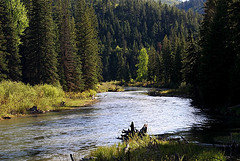Partners for Conservation
By: Amos S. Eno
Posted on:11/17/2011Looking for a few good private landowners to make important things happen across the country.
Last week, we offered Jim Stone's 2010 testimony before Congress. This week and the week after Thanksgiving, we'll hear more about Jim's ideas for landowners coming together and standing up for their land and their stewardship.
“My parents were doing conservation stuff in the 70s, before it was cool, and some people did not understand. One of the first conservation easements in Montana was along the Blackfoot. It’s a tool that allowed us to preserve our ranch.”

So begins the story of Jim Stone, owner of the Rolling Stone Ranch in Montana and mover & shaker within the Blackfoot Challenge. The Challenge is a coalition of rural communities within the 1.5 million acre Blackfoot River watershed practicing “cooperative conservation” to address issues important to them. “I often talk about my parents' decision as their '70s moment,' and I’ve wondered what my '70s moment' would be. What’s my contribution?”
Well, working to create 41,000 acres of cooperatively managed land, boosting landowner autonomy while conserving the Blackfoot River and its habitats might be enough for most people. A lot of people would even settle for protecting their own 2800 acres of cow/calf operation through conservation easements. But not Jim.
“For me, my 70s moment is Partners for Conservation. It’s to transfer the model that landowners in the Blackfoot started in 1993, which has worked all the way to today, and move that model - of sitting down as landowners and working together to solve problems - to other parts of the country.
“We do such great things on the ground, but what sets us apart is really the people, it’s what we have in common, and that’s what’s transferable to other people all around the country. So often we forget that. It almost seems as if we’ve forgotten how to find common ground in this country. But we’re seeing a real change in landowners all across the country now. They see what is happening, and they’re saying, ‘wow, we’ve got to be the ones to do something.’”
“Right now,” says Jim, “we, as landowners, are at a critical juncture. Do we sit back and go with the direction of the country, or do we stand up and say it’s important: private lands and rural values!? Clean water, clean air, and wildlife are almost solely dependent on private lands. How do we make sure the connectivity stays and keeps us in business?"
The idea behind PFC is to find and engage with landowners in each state, those who are doing innovative things and are willing to serve as leaders to their communities. Right now PFC is only in 23 states, (SD, KS, ID, MT, WI, ND, NV, NE, NM, MS, CO, LA, WY, AR, CA, CT, WA, IN, WV, OK, TX, FL, UT) but their goal is to represent all 50 states. Why?
“Well,” explains Jim, “when I go to one of our three representatives in Montana (two senators and a representative) to discuss the Farm Bill with them, and I ask for something, I’m competing against your state for the same dollars. When our Senator, Max Baucus, goes to the committees he serves on (Chairman of Senate Finance and member of Senate Agriculture) to represent Montana’s interests, the committee members horse trade between states. So what we need is the entire landowner community speaking as one so that the entire committee is hearing the same issues from their constituents across the country. In DC, it’s important to tell a good story.”
Return the week after Thanksgiving to hear the rest of Jim’s story: why landowners need to organize and get involved in local and national issues, and secrets to the Blackfoot Challenge coalition’s success. During Thanksgiving week, we'll have a special post about - what else? - the things we, and other famous Americans, are thankful for.
 Sign In
Sign In
 Sign In
Sign In
